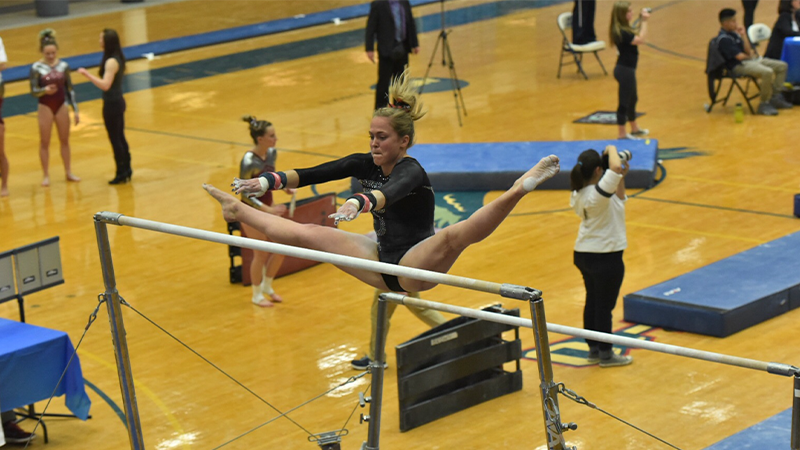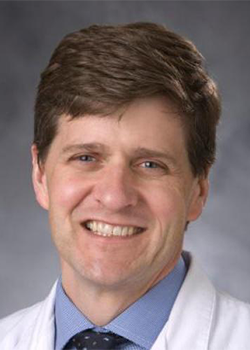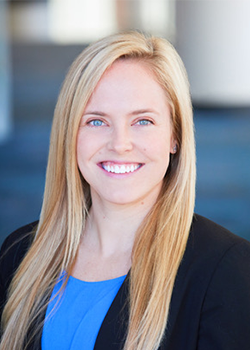
A Fighting Chance Against Infection
Growing up as an athlete, specifically as a gymnast, Tori Kinamon was always acutely aware of what her body could do when it was healthy and what her body couldn’t do when she had a musculoskeletal injury.
But rather than a fracture or sprain, it would be a nearly catastrophic staph infection during her freshman year at Brown University that sidelined Kinamon and catapulted her on a health journey that would inspire her research pursuits and how she hopes to deliver care as a doctor.
“Honestly, it was the most unexpected and frightening experience of my life,” said Kinamon, a third-year medical student at Duke University School of Medicine. “It wasn’t fun to go through at the time, but it certainly changed who I am for the better. I will be a different and better doctor because of that infection.”
The Peachtree City, Georgia, native acquired a severe methicillin-resistant Staphylococcus aureus (MRSA) infection. MRSA is most common among athletes in contact sports. Still, the risk is present in any sport where athletes use shared equipment or have cuts and abrasions that, if left uncovered, make it easier for MRSA to enter the body and cause infection.
Her infection presented differently than typical staph infections, with gradual onset of pain and swelling rather than an open wound. She underwent eight surgeries, spent over a month in the hospital, partly in the intensive care unit, and faced the possibility of losing her leg.
“As a matter of fact, there were multiple surgeries where I went to sleep not knowing if I would wake up with both of my legs because the infection was so severe. As a 19-year-old collegiate athlete who had never been sick, that was terrifying for me,” she said.
Antibiotics and surgery were vital to her treatment. Although she didn’t fully realize it then, the more she knows now about medicine, Kinamon understands how lucky she was to survive and have access to high-quality care.
She was admitted to the hospital for treatment with antibiotics delivered through an IV. But after 48 hours, there was no improvement. Imaging studies showed she had an abscess — basically a walled-off pocket of infection — in her posterior thigh that antibiotics couldn’t reach.

Doctors rushed her to surgery to remove dead and infected tissue, along with treatment with vancomycin, one of the strongest antibiotics available to treat MRSA. But vancomycin is known to be toxic to kidneys, and Kinamon’s started failing. She was switched to another antibiotic that she could tolerate better.
Supported by family, she was discharged home, but it didn’t mean her journey with the drug-resistant infection was over. There would be months of follow-up appointments with infectious disease specialists, plastic surgeons, and extensive physical therapy to learn to use her leg again.
“I am a direct beneficiary of the fact that we had an extra antibiotic in the stockpile when vancomycin was too toxic for my body to handle,” she said. “That’s why I think that antibiotic research and development is so important in this age when we have increasing rates of antibiotic resistance.”
In addition to MRSA, a growing number of infections — such as pneumonia, tuberculosis, gonorrhea, and salmonellosis — are becoming harder to treat because antibiotics used to treat them have become less effective.
As she looks to her future medical career, she says: “I don’t want to look a patient in the eye, or their family in the eye, and tell them they have an infection that we can’t treat. I want patients to have the outcome I was lucky enough to have.”
Team Medicine

As a medical student at Duke, Kinamon reached out to renowned researcher in staph aureus Vance Fowler, MD, the Florence McAlister Distinguished Professor of Medicine and professor of molecular genetics and microbiology. She asked if she could get involved in infectious disease research projects.
The Duke medical school curriculum is designed for clinical skill-building in years one and two. In the third year, medical students delve into research, yet Kinamon was ready to tackle the threat of antibiotic resistance on Day One.
“Okay, clearly this is a person who’s driven,” Fowler remembers. He gave her a project, not expecting much. But 10 months after their first conversation, she presented her findings on MRSA and the spine at a scientific meeting.
“It was quite astonishing, actually,” said Fowler, who serves on the Antibacterial Resistance Leadership Group (ARLG), a national group of infectious disease experts funded by the National Institutes of Health to execute clinical research in drug-resistant bacteria.
“She really is exceptional,” he said, referring to Kinamon’s authorship of multiple publications in the works for scientific journals, participation in an ARLG panel discussion and an infectious disease conference in Dublin, Ireland, and recent selection for a competitive fellowship from the Oak Ridge Institute for Science and Education (ORISE).
As an ORISE fellow she has served as a catalyst for advancing a new way of looking at antibiotic clinical trials based on desirability of outcome ranking, known as DOOR. It provides doctors and regulators with a better view of the overall outcomes of patients in a clinical trial.
“I think given the fact that the antibiotic pipeline is running dry and our ability to study them is made more difficult by an exodus of pharmaceutical research, I couldn’t imagine a more important area for her to focus her career on than working to understand and prevent infections and how to treat them,” Fowler said.

Fowler’s own family faced an unexpected ordeal with a group B strep infection that emerged weeks after his daughter, a runner, had knee surgery. The infection required multiple follow-up surgeries to resolve, and the daunting experience inspired her career in public health and disability research.
I see a lot of parallels between gymnastics, or other collegiate athletics, and medicine. Both require a high level of commitment, perseverance, and composure under pressure. More notably, they are both team sports.
“I have a lot of respect for both women and their ability to take a circumstance that life hands you, which you have no control over, and ultimately make something really positive out of it,” Fowler said.
Kinamon set her sights on Duke University School of Medicine during her junior year of college, drawn to the school’s research enterprise.
“One of the things that drew me to Duke, and that I’ve been impressed with time and time again, is that this institution creates leaders in all fields of medicine,” she said. “I aspire to be that. I have been blessed with examples such as Dr. Fowler. He’s a leader in the field; I see how he leads and cares for his lab and the ARLG, I see how he strives for innovation and excellence in research, and I see his care for and dedication to his patients. I want to do the same.”
Her personal experience with a drug-resistant infection drives her work and her commitment to a patient-centered approach to care: “I think, ‘What type of doctor did I like having stand beside me when I was in the hospital bed?’”
Kinamon has helped other athletes by designing an infection prevention protocol with the Duke Infection Control Outreach Network. The guidelines are designed to help high school and collegiate athletes to reduce the risk of MRSA and other infections acquired from athletic settings.
That means, she says, arranging athletic training rooms to make it easier to sanitize hands when entering and exiting a training room, wiping down benches between uses, showering immediately after practice, and educating atletes on potential signs and symptoms of infection.
“I see a lot of parallels between gymnastics, or other collegiate athletics, and medicine,” Kinamon said. “Both require a high level of committment, perseverance, and composure under pressure. More notably, they are both team sports. Medicine requires a team effort, all in the name of high-quality patient care. I look forward to being part of that team in the near future.”
Shantell M. Kirkendoll is a senior writer and managing editor for Duke University School of Medicine Strategic Communications. Aalyissa Cooley, a communications intern and North Carolina Central University student, contributed.
Photography by Jim Rogalski
Main Photo: Tori Kinamon is a third-year medical student at Duke University School of Medicine.
